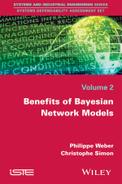Foreword by L. Portinale
Probabilistic graphical models and Bayesian belief networks, in particular, have definitely become a reference formalism in dependability modeling and assessment. The graphical structure, together with the compact representation of the joint distribution of the system variables of interest, provides the reliability engineer with a powerful tool at both the modeling and analytical levels.
The dependency structure, induced by the graph component of the formalism, allows the modeler to make explicit a set of reasonable independence assumptions that may lead to huge simplification at the computational level, as well as with respect to the problem of probability elicitation, without compromising the suitability of the model produced to the actual real-world application.
Standard dependability models usually fit into two categories: 1) combinatorial models (as fault trees or reliability block diagrams) – they determine the occurrence of an undesired event through a combinatorial composition of sub-events; this class of model is very easy to analyze, but it cannot model situations involving complex dependencies among system components and sub-systems; 2) state–space models (such as Markov chains or petri nets) – they allow complex interactions among system parts to be modeled, but they may incur the “state-explosion” problem; this usually means that the analysis has to be performed by considering the cross-product of the system variables, producing a potentially huge number of states.
Bayesian networks and related models allow for efficient factorization of the set of system states, without the need for an explicit representation of the whole joint distribution; moreover it has the additional advantage of inference algorithms available for the analysis of any a posteriori situation of interest (i.e. evidence can be gathered by a monitoring system and fed into a dependability framework for fault detection and identification). Finally, when time is explicitly taken into account, models such as dynamic Bayesian networks result in a factored representation of a Markov chain, providing a framework with the modeling advantages of state–space models, without the drawbacks at the analytical level.
The present book, written by some of the most respected researchers and practitioners in the field, provides a comprehensive presentation and analysis of the probabilistic graphical model approach to dependability, providing a view of the different facets involved in real-world dependability applications: system reliability, maintenance and risk evaluation. The main objective is to devise a principled approach to the modeling of complex dependable systems, with the aim of supporting decisions in an uncertain and evolving setting. This supports and promotes Bayesian networks and probabilistic graphical models as some of the most relevant and important formalisms in modern dependability analysis.
